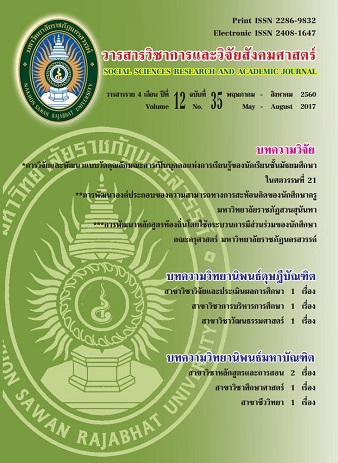การพัฒนาองค์ประกอบของความสามารถทางการสะท้อนคิดของนักศึกษาครู มหาวิทยาลัยราชภัฏสวนสุนันทา; Development of Reflective Thinking Factors for Student Teachers in Suan Sunandha Rajabhat University
Main Article Content
Abstract
การวิจัยนี้มีวัตถุประสงค์เพื่อพัฒนาโมเดลการวัดความสามารถทางการสะท้อนคิดของนักศึกษาครู และตรวจสอบความตรงเชิงโครงสร้างของโมเดล กลุ่มตัวอย่างการวิจัยคือ นักศึกษาครูชั้นปีที่ 1-5 มหาวิทยาลัยราชภัฏสวนสุนันทา ปีการศึกษา 2558 จำนวน 750 คน สุ่มโดยวิธีแบ่งชั้นหลายระดับ เครื่องมือรวบรวมข้อมูลคือ แบบสอบถามเกี่ยวกับคุณลักษณะของการสะท้อนคิด ชนิดมาตรประมาณค่า 5 ระดับ มีค่าสัมประสิทธิ์ความเที่ยงเชิงความสอดคล้องภายใน .824 วิเคราะห์ข้อมูลโดยวิธีวิเคราะห์องค์ประกอบเชิงสำรวจ ที่มีการหมุนแกนแบบ
ตั้งฉากด้วยโปรแกรม SPSS for window และวิเคราะห์องค์ประกอบเชิงยืนยันอันดับที่สองโดยโปรแกรมลิสเรล เวอร์ชัน 9.2
ผลการวิจัย พบว่า
- โมเดลการวัดความสามารถทางการสะท้อนคิดมีองค์ประกอบหลัก 3 ด้าน ได้แก่ ความสามารถด้านการวิเคราะห์และประเมินตนเอง ความตระหนักในวิธีเรียนรู้ของตนเอง และทักษะการเรียนรู้ตลอดชีวิต
- โมเดลการวัดที่พัฒนาขึ้นมีความสอดคล้องกับข้อมูลเชิงประจักษ์ ด้วยค่าดัชนีความสอดคล้องของโมเดลดังนี้ c2 = 79.99 df = 32 P-value = 0.100 RMSEA = 0.065 GFI = 0.96 AGFI = 0.93 CFI = 0.96 และ SRMR = 0.047 โมเดลที่ได้มีความสอดคล้องกับการกำหนดความจำเพาะของโมเดล (model specification) และความเป็นไปได้ค่าเดียว ที่ประกอบด้วย 3 องค์ประกอบ และตัวแปรบ่งชี้ 20 ตัว ค่าน้ำหนักองค์ประกอบของตัวแปรบ่งชี้ทุกตัวมีนัยสำคัญทางสถิติ (t >|1.96|) และโมเดลที่พัฒนาขึ้นมีความตรงเชิงโครงสร้างชนิดลู่เข้าในระดับดี แสดงด้วยค่าเฉลี่ยของน้ำหนักองค์ประกอบยกกำลังสองของตัวแปรบ่งชี้ของแต่ละโครงสร้าง (Average Variance Extracted, AVE) ที่มีค่ามากกว่า 0.5
Abstract
This study aimed to develop a measurement model of reflective thinking ability and to determind its construct validity. The participations of the study were 750 the 1st-5th year student teachers in Suan Sunandha Rajabhat University in academic year 2015. They were selected by multi-stage stratified random sampling. The participations were explored their characteristic of reflective thinking by 5-point rating scale. Cronbach’s Alpha internal consistency was estimated for the scale which indicated .824. Data were analyzed by means of exploratory factor analysis with orthogonal rotation method using SPSS for windows and the second order confirmatory factor analysis using LISREL version 9.2.
The major findings were as follows:
- The exploratory factor analysis indicated the measurement model of the reflective thinking were composed of 3 factors as of following: Self Analysis and Evaluation, Awareness in Self-direct Learning, and Life Long Learning Skills.
- The second order confirmatory factor analysis found that the model was consistent with empirical data which the overall goodness of fit index were: chi-square goodness of fit test was 79.99, df=32, P-value=0.100, RMSEA= 0.065, GFI=0.96, AGFI=0.93, CFI=0.96, and SRMR=0.047. The developed model was concordance with the rule of model specification and model identification. It was composited of three factors and 20 indicators, which all their factor loadings were statistics significant (t >|1.96|). And the model was indicated its convergent validity by the average of multiple of factor loadings of each construct (Average Variance Extracted, AVE) that was higher than 0.5.


